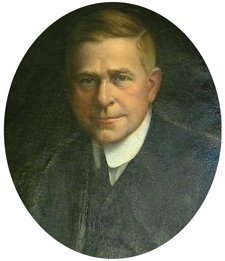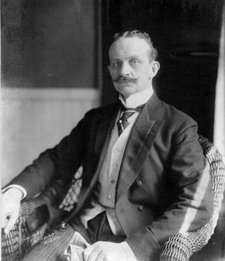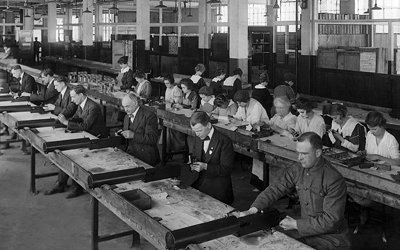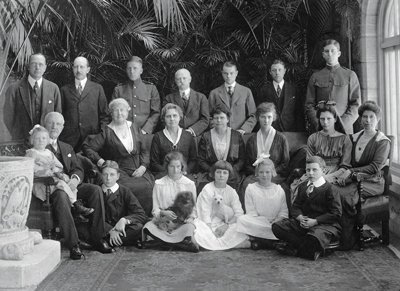The first in a series of essays featured in conjunction with Greenwich Faces the Great War.
By Volunteer Researcher Karin Crooks

In September 1913 a quiet, unassuming businessman, Samuel (Sam) Frazier Pryor (1865–1934), arrived in Greenwich to start a new career, uprooting his family from their life near St. Louis, Missouri. At 48, Sam Pryor was a self-made man who, after high school, had worked his way up through the railroad supply business to become president of Southern Wheel Company. Sam’s new employer, the family of William Rockefeller (1841–1922), was already established in Greenwich and famous worldwide for its wealth. In his new position as General Manager and Vice President of Remington Arms-Union Metallic Cartridges Co. (Remington), Sam would report to two bosses: William’s second son, Percy A. Rockefeller (1878–1934), the young head of the family business; and William’s son-in-law, Marcellus (Marcy) Hartley Dodge (1888–1963), the sole stockholder of Remington. Sam then hired the architectural firm of Cross & Cross to design his new Greenwich home, The Pryory, on Field Point Circle.

On June 28, 1914, the assassination of Archduke Franz Ferdinand began The Great War (WWI). It also upended Sam Pryor’s new life in Greenwich, as it did for many other Greenwich residents. The war impacted Sam’s employer immediately. First, the New York Stock Exchange closed its doors on July 31. Marcy and his wife were stranded while traveling in Europe. Fall of 1914 brought orders to Remington from the Allies for millions of rifles and ammunition. Sam’s business acumen and energy drove the expansion of the Remington factories in 1915 from an old-line company of well-crafted sporting guns to a modern manufacturer of military arms, with over five plants in five states. The scope of this increase in capacity—in size of plants and in the speed with which they were built and staffed–understandably was viewed by the press as “Aladdin’s Palace,” the luxurious Bridgeport plant which rose out of thin air, and as “Pryor’s Master Stroke.”

The German ambassador to America, Count Johann von Bernstorff, had been ordered to use all means to prevent American munitions from reaching the Allies. In the battle for the heart of America and public opinion, the suave and sophisticated Count von Bernstorff and his agents frequently employed public slander to garner American support by attacking American munitions makers. When von Bernstorff charged that Remington was supplying “dum-dum” bullets to the English (which would have been in contravention of international law), Sam responded by letter to the Count, published in The New York Times on December 15, 1914, vigorously denying the Count’s allegation and demanding that he retract it or come to Remington headquarters to see the proof for himself.

The battle was also fought with pure cash. In June 1915, Sam was called upon to deny possible sales of Remington arms to the Germans, based on an offer from a von Bernstorff agent to buy the company for $15,000,000. Sam Pryor’s most famous published statement, to be repeated in his obituary, assured the American public that the American arms business was not to be bought out by foreign parties: “No sum that might be offered would tempt this company to sell out and repudiate existing contracts.”
A third battle was fought for the loyalty of Remington’s workers, as von Bernstorff’s agents fomented strikes in various factories along the East Coast by bribing local union members. Sam’s management of Remington was tested most greatly by a strike threatened at the Bridgeport plant under suspicious circumstances in July 1915. Had this strike spread to the other New England munitions plants, it would have dealt a most serious blow to the Allies.

In 1916, there were new challenges to Remington. Explosions of munitions continued, topped by one in June at Tom’s Island in New York Harbor, breaking windows as far north as Wall Street, where Remington’s offices were located. Most challenging, the Allied buyers kept changing their order specifications for rifles, causing backups, overruns and financial losses. At the end of 1916, control of Remington was reorganized and shifted from the owner, Marcy, to the lenders, controlled by Percy. Sam Pryor was made Chairman of the Executive Committee of Remington, a position he held until 1931.
By the end of the war, Remington Arms had produced over 50% of all American rifles used by US troops; its affiliate, Union Metallic Cartridges Co., had produced over 50% of all small arms ammunition used by the US or the Allies during the war. Locally, Sam served as treasurer of the Greenwich Home Gardens Association, organizers of the town’s major food drive for the war.
Our deep appreciation goes to essayist Karin Crooks for producing this article and for her tireless efforts in support of Greenwich Faces The Great War.
Greenwich Women Face the Great War >